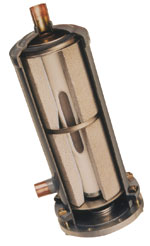Because of its chemical composition, a POE lubricant has the ability to suspend and circulate a large concentration of particles in the system. Circulating particles cause adverse compressor wear, and lead to nuisance plug-ups at thermostatic expansion valves, solenoid valves, pressure regulating valves, and oil level controls.
If these contaminants are not removed at system startup (or after retrofit to the HFC refrigerant and POE lubricant), the subsequent valve plug-up requires a service call. For this reason, it is necessary to use dry nitrogen to minimize copper oxide formation during brazing.
For a typical parallel compressor rack system, let's assume replaceable core filter-drier shells are installed in the liquid and suction line. Here then are some suggestions to minimize repeat callbacks because of particles in circulation.
Install A High-Performance Oil Filter
High-performance oil filters can remove the tiniest of particles (i.e., two microns) at a high efficiency so they do not collect and affect system components. The design conditions of the oil return line in the oil management system allow for such performance.With the slow oil flow rates in the oil management circuit of systems that utilize reciprocating and scroll compressors, a good oil filter can remove a large amount of contaminant. Although these products are more costly, they virtually eliminate the need to change the lubricant because of suspended particles in circulation.

The recommended locations for oil filter types in low-pressure oil return systems are illustrated in Figure 1. The oil filters are also suggested in the oil return line between the oil separator/reservoir and pressure differential valve(s) on high-pressure oil return systems.

Replaceable secondary filters are available for some liquid line replaceable core filter-drier shells. Most replaceable core filter-drier shells are designed with a nominal filter rating of removing 40-micron-sized particles. The inclusion of an optional secondary filter improves the nominal filter rating to 20-micron-sized particles.
This filter-within-a-filter concept is beneficial at system startup or on ‘trouble' jobs where the system is highly contaminated.
This option can be used for other applications if desired. The secondary filter can be left in the system or removed after cleanup.
A possibility for new systems is to install a small filter-drier immediately upstream of each refrigerated case. Although this action requires more upfront cost, these filter-driers prevent repeated thermostatic expansion valve plug-ups after startup.

One cannot overstate the importance of using dry nitrogen during brazing and following other recommended practices to minimize repeat callbacks because of debris introduced at startup. Installation of a high-performance oil filter in the oil management system will remove the smaller particles in circulation. In other circumstances, several approaches can be reviewed to determine the best method to clean the system.
Gildehaus is with Sporlan Valve Co. For more information, visit www.sporlan.com.
Publication date: 09/06/2004

Report Abusive Comment